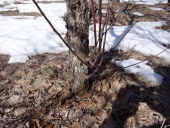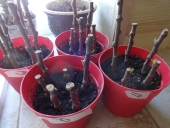
 2
2




 1
1




 4
4




 1
1




Mark Reynolds wrote:I don't have an orchard so I can't say for sure, but.....
I would say 'no' to summer as trees have largely stopped growing for the year by that point and are sequestering food for the next year. Not a good time to initiate growth. I'd say 'no' to the fall as well. I suspect you would get a lot of die back over the winter which isn't something you want. Winter would be better than fall, but you will probably still get some dieback, and you are removing most all buds for the next year. Maybe early spring before bud break? Yu won't get much dieback, but again, removing all the new buds. I'd say cut it sometime after buds have become active but way before the tree stops growing for the year, which translates to somewhat early to mid spring. The tree will interpret this as a growing leaf loss and will immediately generate new growth from the remaining stump with lots of growing season left. Cutting at this time in this way might produce what I coined as 'compensatory growth' which is growth above and beyond what would be expected had the tree not been defoliated. I did my MS thesis on browse utilization and researched that browsing often results in more twig growth produced for the year than if no browsing had taken place to begin with.
That's my best guess, theory, and explanation.
 2
2




Tim Mackson wrote:
Mark Reynolds wrote:I don't have an orchard so I can't say for sure, but.....
I would say 'no' to summer as trees have largely stopped growing for the year by that point and are sequestering food for the next year. Not a good time to initiate growth. I'd say 'no' to the fall as well. I suspect you would get a lot of die back over the winter which isn't something you want. Winter would be better than fall, but you will probably still get some dieback, and you are removing most all buds for the next year. Maybe early spring before bud break? Yu won't get much dieback, but again, removing all the new buds. I'd say cut it sometime after buds have become active but way before the tree stops growing for the year, which translates to somewhat early to mid spring. The tree will interpret this as a growing leaf loss and will immediately generate new growth from the remaining stump with lots of growing season left. Cutting at this time in this way might produce what I coined as 'compensatory growth' which is growth above and beyond what would be expected had the tree not been defoliated. I did my MS thesis on browse utilization and researched that browsing often results in more twig growth produced for the year than if no browsing had taken place to begin with.
That's my best guess, theory, and explanation.
Thank you Mark, You gave me a lot of good information that I didn't know. It certainly changed my direction because I had planned on cutting down the tree as soon as it went dormant. Now I think that I'm going to do it just a little after I finish my grafting for the season. Sort of a lie in a way because I have very little left to graft to and I have grafts almost everywhere now. That's why I need a stooling bed.
I got to thinking about cutting the tree and how I should do it. I can't think that it would matter, but would cutting the stump low to the ground change how the tree reacts? The reason that I ask is because the orchard that I'm involved with has many trees that were cut with no signs of rootstock suckers ever appearing. Maybe it was the time of year that the trees were cut, maybe the root system was already sick and dying - I'm not sure. All that I do know is that there are stumps about two feet high and barren.
Thank you again! Stay awesome! Tim





|
Because there is no spoon. Just a tiny ad:
The new purple deck of permaculture playing cards
https://www.kickstarter.com/projects/paulwheaton/garden-cards
|


